Learn how long to wear a knee brace for torn meniscus recovery, ensuring effective healing and support during your rehabilitation process.
A torn meniscus is a common knee injury among especially athletes. It causes a degree of discomfort, damage to the athlete’s cartilage, pain, and swelling. A frequent question that arises is, “For what duration should a brace be worn following a torn meniscus? Therapeutic intervention in the form of wearing a knee brace helps improve aid mobility and also safeguards against further damage.
Lessons on the use of the brace and strict adherence to a well-designed rehabilitation therapy program increases the probability of successful rehabilitation. Such guidance, alongside appropriate healthcare practitioners, enables recovery of strength and mobility.
The Complete Guide to Managing Recovery With a Knee Brace for Meniscus Tears
If sustaining a meniscus tear recently, knowing the specifics of managing your injury is critical. A torn meniscus certainly is painful, and it can restrict your daily activities. Most individuals discover that a knee brace serves as a critical component of their treatment protocol. In this blog, we will cover everything you need to know regarding knee braces for meniscus tear, including recovery time and duration of brace use, along with strategies for the rehabilitation process.
What Causes A Meniscus Tear?
A meniscus tear occurs when the cushioning in your knee joint, known as meniscal cartilage, sustains damage. This type of injury commonly occurs during sporting events or physical activities that involve twisting motions or sudden stops. If the meniscus tears, you may experience sharp pain and swelling while your knee stiffens. In some cases, patients may also experience a popping sensation and find knee movement or weight bearing difficult. It’s crucial to seek medical attention if you have these symptoms. In order to confirm the diagnosis, your doctor may order an MRI of the knee, targeting the suspected meniscal tear. In coordination with a full assessment, your doctor will develop an appropriate orthopedic treatment plan tailored to your needs. This may include rest, ice, compression, elevation, or in more severe cases, surgical intervention.
Does a Knee Brace Help a Torn Meniscus Heal?
A knee brace has considerable advantages for the healing process of a torn meniscus. A knee brace helps by securing the knee joint and preventing it from sustaining additional injuries. It serves as a protective device that mitigates pain and enhances mobility. Although the brace does not resolve the tear on its own, it aids in the repairing process by maintaining stability of the knee joint. Active individuals often feel more secure and are able to perform some of their daily routines with reduced discomfort while wearing a brace.
How Long Should You Wear a Knee Brace for a Meniscus Tear?
The duration for wearing a knee brace varies based on your specific circumstances and medical assessment. Typically, it is accepted that most individuals should wear a brace for weeks after sustaining an injury. If you are participating in more demanding activities, or if your knee feels unstable, greater support may be necessary. As your condition improves and strength increases, the recommendation may shift toward wearing the brace only during certain activities. It is critical to pay attention to how your body feels. In case you still exhibit signs of injury, wearing the brace is advisable for the time being.
When Is It Suitable To Stop Wearing a Brace?
The decision to no longer wear a knee brace is best made when there are no longer any significant swelling or pain symptoms, and a reasonably good range of movement is achieved. Your healthcare provider will assist you in making that decision based on your specific recovery details. This is the right time to be removing the brace to avoid the possibility of recurrent injuries. Recurrent discomfort is another possibility if you do not evaluate the knee carefully and seek timely medical input.
Is It Possible To Wear A Knee Brace Continuously?
Wearing a knee brace is advisable while engaging in various activities that require additional support to the knee. Nevertheless, you do not want to wear the brace at all times. Allowing your knee to rest without the brace during sleep or when sitting comfortably at home can go a long way in avoiding atrophy. If the decision to wear a brace for extended periods is made, care should be taken in ensuring the brace does not rub or press on the skin causing pain, and fit properly.
Is It Safe to Sleep with a Knee Brace On?
The concern, “is it safe to sleep with a knee brace on?” is common and the answer is usually yes as long as comfort levels are balanced. Usually, a doctor will advise wearing a brace while sleeping, in that case, make sure it is properly fitted. Tightness with any object worn should be avoided since tightness leads to snugness that aids in support but also compresses blood flow and induces pain. If any form of discomfort is felt while sleeping then an adjustment or removal is recommended.
Mistakes to Avoid When Wearing a Knee Brace
There are common mistakes to avoid when using a knee brace for a torn meniscus. One such mistake is wearing an inappropriate type of brace. It might range from simple sleeves to more complex hinged braces. Follow your doctor’s recommendations so that the best brace can be selected. Another common mistake occurs when the individual stops progressing through the rehabilitation stages; physical therapy is essential and wearing a brace should not encourage avoidance of the therapy sessions. Although braces provide immediate relief, exercising muscles after a knee injury results in much better stable and strong knee joint for the future.
Any knee ailment, be it a meniscus tear, arthritis, or ligament injuries including ACL and MCL strains, can cause severe pain. The brace should offer appropriate pain alleviation, improved movement, and provide support without restricting mobility.
Through extensive testing and research, we have evaluated the seven best knee braces based on their construction, materials, adjustability, and practicality to aid you in making the best choice.
1. EXOUS BODYGEAR 4-Way Adjustable Knee Brace
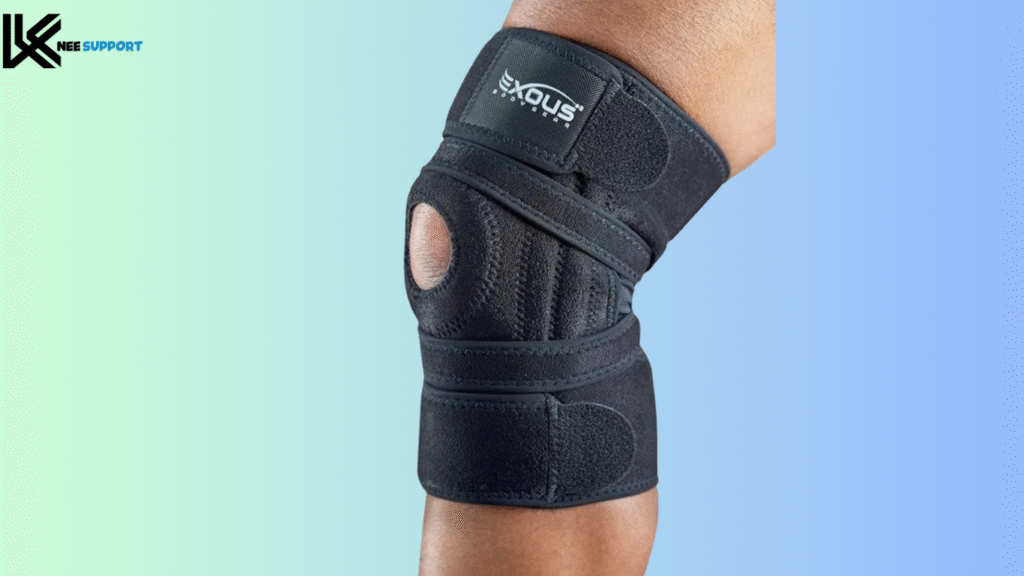
Best For: Active people and Athletes looking for compression and support that can be adjusted.
Key Features
EXOUS BODYGEAR’s 4-point strap system patented knee brace is unique because the straps are meant to be placed over the knee joint equally, ensuring balanced compression. Many knee braces depend on a singular center strap, but this brace’s use of four independent anchor points allows for tailoring of tightness to individual needs. The MCL and LCL stabilizers contribute to a reinforced ‘buttress effect’ which enhances invaluable supportive stabilization for kneecap wobbling during high impact sports such as running, basketball, or hiking.
Flexibility, along with comfort, is gained by the low-profile design located behind the knee, where two thinner straps reduce bulk. Unlike traditional braces that use thick padding which restricts movement, this model enhances flexibility without sacrificing stability. This model is suitable for patellar tendonitis or post-surgical recovery due to the open patella design which alleviates pressure on the patella.
3 inches above the knee measurement places this thigh brace at twenty inches, highlighting the critical aspect of sizing. If this measurement surpasses the limit, the alternative option is a larger brace.
Pros & Cons
Pros:
- No slipping or need for readjustment during wear in intense activity
- Breathable, lightweight materials that prevent overheating
- Superior stabilizing support for ligament injuries (ACL, MCL, or meniscus tears)
Cons:
- Not appropriate for larger thighs (max 20″)
- If not properly adjusted, may feel overly tight
Best use cases:
- Sports performance – running, basketball or soccer
- Post-injury rehabilitation – meniscus tears or mild ligament strains
- Management of arthritic pain.
Geno Fit Hinged Knee Brace – Maximum Support for Severe Injuries
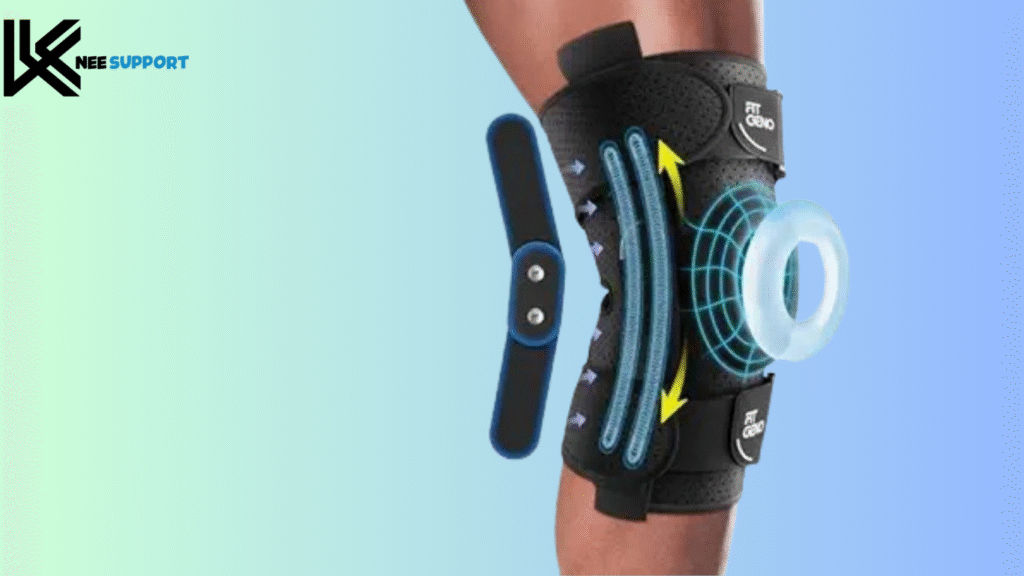
Best for: Post surgery recovery, ACL tears, and instability deemed as severe.
Key Features
The Fit Geno ReActive+ hinged knee brace provides maximum medical-grade support and rehabilitative healing. Protective lateral movements are prevented by rigid dual aluminum hinges that provide lateral stability. These hinges are removable, which allows for gradual adjustment from total immobilization (post-surgery) to moderate support as healing occurs.
Another feature includes a medical-grade gel cushion that surrounds the patella and absorbs shock while flexion and extension are occurring. Bunching is prevented by an open back design and anti-slip silicone strips that keep the brace in place during even the most vigorous and high-intensity workouts.
Knee braces need to be comfortable in order for them to be worn for long periods of time. The soft latex-free material does not chafe and also pulls sweat away from the body. This specific model is often recommended by sports medicine specialists for ACL rehab because of adjustable compression and support of the knee joint alignment.
Pros and Cons
Pros:
- Best suited for post-operative care and severe ligament tears
- Provides unmatched stability with brakes
- Non-slip during running or jumping
Cons:
- Somewhat bulky for casual use
- Braces may pinch from over-tightening
Best Use Cases:
- Recovering from ACL or MCL injuries.
- After surgery, maintaining the knee in a stabilized posture.
- Protection from high-impact sports activities.
Sparthos Hinged Knee Brace – Optimal Stability for Active Lifestyles
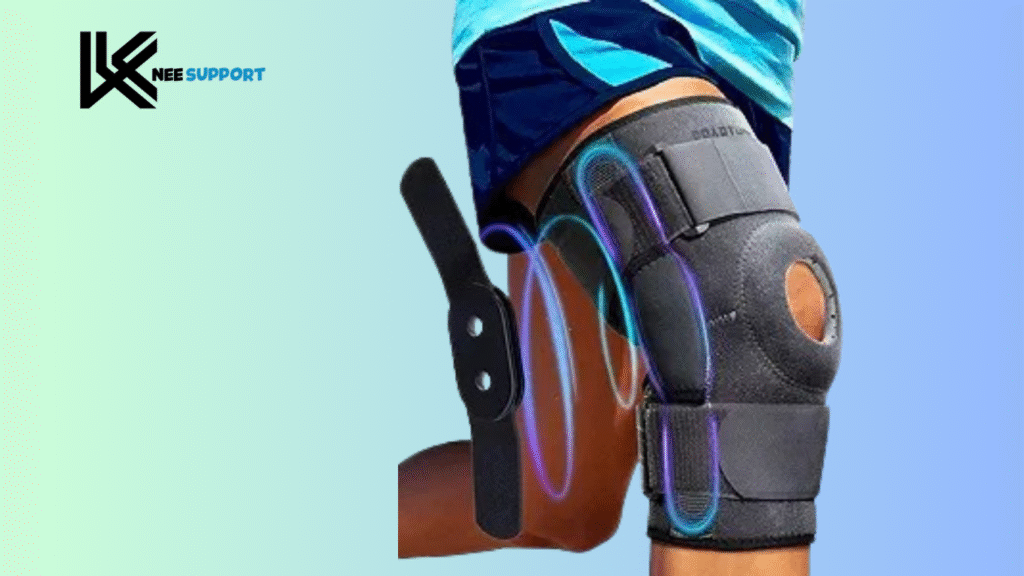
Most appropriate for: Preventing knee buckling and providing moderate to strong support.
Key Features
The Sparthos Hinged Knee Brace is excellent for ACL, MCL, and meniscus injuries thanks to its dual aluminum hinges that offer both lateral and medial support. Unlike bulky rigid braces that are heavy and limit mobility, the Sparthos is lightweight as it has hinges that flex with your movement, preventing sideways motion instead of bracing against it.
The brace’s open-patella design eases pressure on the kneecap. Moreover, secured non-slip fit, is achieved with four adjustabble Velcro straps. While providing compression, the neoprene material is breathable, thus preventing overheating. In addition, anti-slip silicone ensures the brace will not slide during running, gym workouts, or other activities.
Pros & Cons
Pros:
- Great for stopping knee destabilization, particularly buckling and hyperextension when the knee flexes.
- Hinged elements provide supportive knee brace function while not impeding motion.
- Good comfort for all-day wear.
Cons:
- Not suitable for larger size users with a thigh measurement over twenty-two inches.
- Hinged parts may need to be re-fixed from time to time.
Best Use Cases:
- Recovery from ACL/MCL injuries.
- Athletic activities like basketball, running, and hiking.
- Knee pain discomfort relief during daily activities.
GARNO Knee Brace – Best for Arthritis & Tendonitis
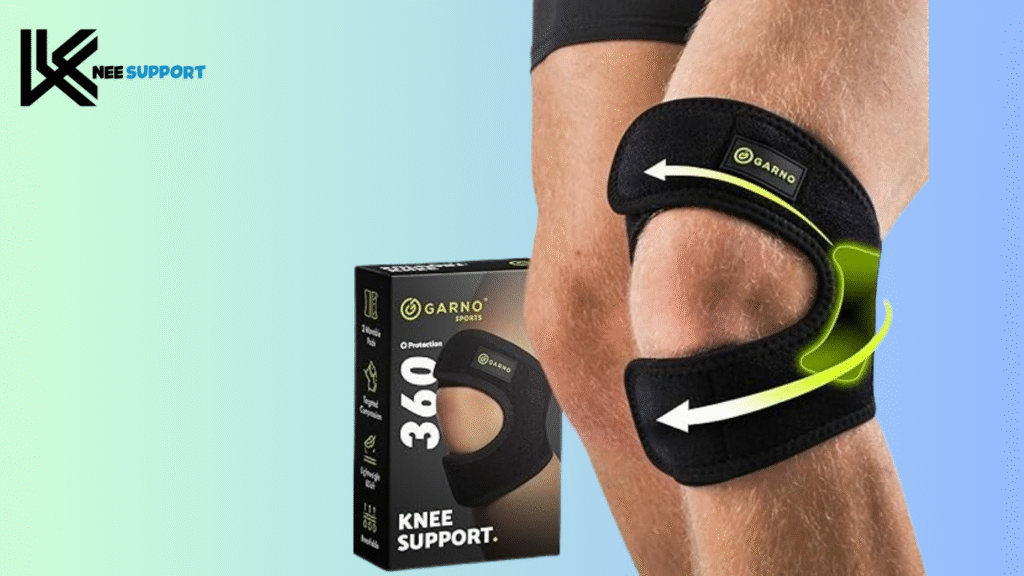
Best for: Comprehensive pain targeting tailoring for 360° compression.
Key Features
Using an X-cross strap system, the GARNO Knee Brace evenly redistributes pressure across the knee joint, alleviating strain on the patella, knee tendons, and ligaments. Its two removable gel pads allow customizable compression, making it effective for arthritis, tendonitis, and issues with patellar tracking.
The brace is constructed from breathable neoprene, which is lightweight and moisture-wicking, reducing skin irritations during extended wear periods. The open back design improves air circulation to the skin, while adjustable Velcro straps enable easy application of pressure-free snug fastening.
Advantages & Disadvantages
Pros:
- It is effective for arthritis and tendonitis discomfort.
- Provides removable gel pads for specific pain relief.
- Discreet fit under clothes.
Cons:
- Not ideal for advanced ligament injuries.
- Could be more forgiving when it comes to excessive sweating.
Best Use Cases:
- Arthritis and chronic joint pain.
- Patellar tendonitis, often referred to as jumper’s knee.
- Mild ligament support.
Galvaran knee brace with side stabilizers offers advanced joint support
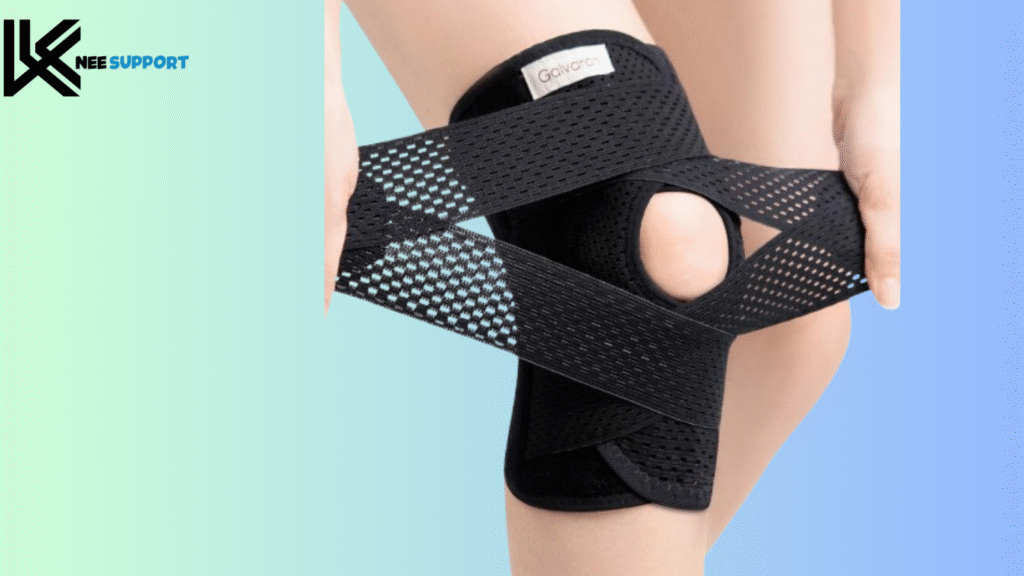
Best for: Active injury prevention and dynamic support.
Key features
The Galvaran Knee Brace is equipped with four memory spring stabilizers, which offer active support during ambulation and sports due to their adaptive nature to the movement of the knee. Its open patella design is ergonomic and helps with kneecap posture, and V-shaped adjustable straps grant appropriate compression.
The mesh material made of denser polyester helps in maintaining the knee cool while preventing slippage with anti-slide silicone strips. Instead of bulky braces, this model is slender yet still supportive, especially during active recuperation phases.
Pros And Cons
Pros:
- Stabilizing while still allowing flexibility, and great for active users.
- Excellent shock absorption.
- Remains in optimal position during intense movement.
Cons:
- Perfectly adjusting the straps takes time.
- Not suitable for extreme swelling and post-surgery immobilization.
Best Use Cases:
- Recovery from a meniscus tear.
- Injury prevention in sports.
- Support for mild to moderate sprains and strains of ligaments.
DOUFURT Knee Brace – Non-Surgical Pain Relief

Best for: Long-term management of chronic knee discomfort
Key Features
To relieve pain caused by meniscus tears, arthritis, and tendonitis, DOUFURT Knee Brace employs a medical-grade gel padded patella. Each side is reinforced with double spiral metal strips which provide flexible yet firm support, helping to stabilize the knee.
The brace also helps to add warmth through a high-quality neoprene materials that retains the heat. This assists in blood circulation as well as improves faster healing. The open-patella design coupled with adjustable Velcro straps ensures comfortable fit without undue constriction while eliminating pressure buildup on the patella.
Pros & Cons
Pros:
- Helps avoid surgery in some cases.
- Excellent for chronic knee pain.
- Comfortable for extended wear.
Cons:
- Bulkier than some alternatives.
- May irritate sensitive skin with prolonged use.
Best Use Cases:
- Meniscus tear pain relief.
- Arthritis & bursitis.
- Post-injury recovery.
ABYON Plus Size Knee Brace – Best for Larger Thighs
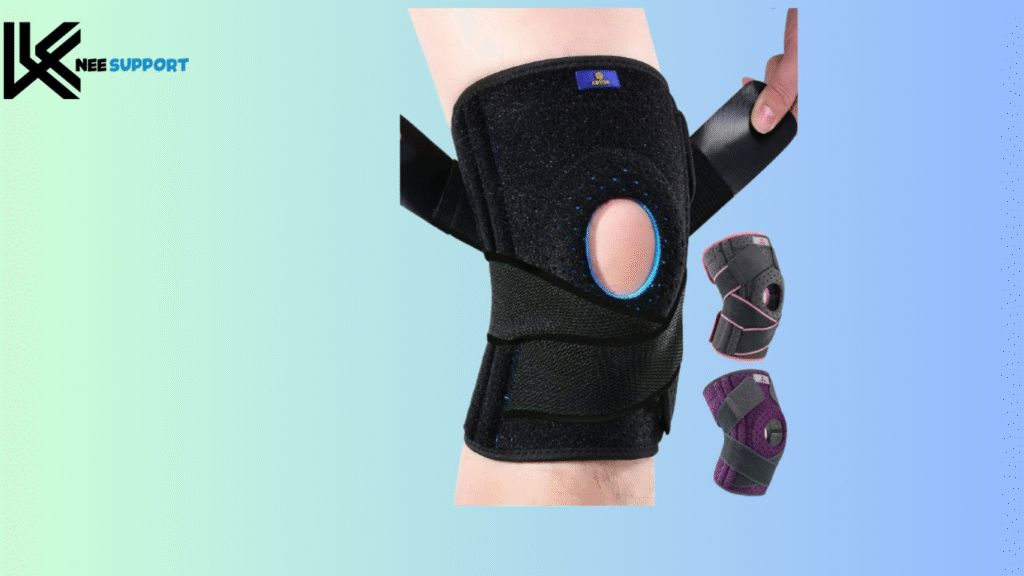
Best for: Plus-size users needing strong support.
Key Features
The ABYON Plus Size Knee Brace is designed for larger thighs (up to 3XL), featuring four stabilizers and an X-ring strap for maximum compression and stability. The medical-grade silicone strips prevent slipping, while the breathable neoprene keeps the knee cool.
The patellar gel pad targets pain alleviation and the brace is eligible for FSA/HSA, which makes it financially wise for post-surgery recovery.
Pros & Cons
Pros:
- Best for plus-size users.
- Strong support for severe instability.
- FSA/HSA eligible.
Cons:
- Slightly heavier due to reinforced design.
- Takes time to break in.
Best Use Cases:
- Plus-size knee support.
- Post-surgery rehab.
- Severe ligament injuries.
Selecting the Appropriate Knee Brace for a Meniscus Injury
It is critical for your recovery process that you select the appropriate knee support for a meniscus injury. Look for a brace that provides support without sacrificing comfort. Supports come in different forms including knee wraps, sleeves, and hinged braces. While sleeves provide compression and light support, hinged braces provide more stability for serious injuries. Your healthcare professional can assist you in determining the best fitting brace for your condition and how to properly adjust the knee brace.
What is the Estimated Time for Full Recovery?
Everyone is unique, and so their recovery time from a meniscus tear is likely to differ. Some individuals may find that only a few weeks of the RICE method (rest, ice, compression, elevation) is sufficient to address the injury. Much more significant tears could be extended to months so long as proper physical therapy is undertaken after any required surgery. Therapy allows you to regain full functionality of your knee over time. Everyone is different, so sticking to your physician’s guidelines in this case will make a positive difference.
Final Reflection: Attend to Your Knee and Healthcare Specialist
Ultimately, the journey of recovering from a meniscus tear can be difficult, but with the right management, progress is achievable. Prioritizing body feedback and professional guidance is critical because they are well-positioned to track progress and provide necessary updates to the approach being utilized. While certain meniscal injuries may appear to be a hassle, a patient with the appropriate supportive aids coupled with a strong willingness to follow through with their recovery plan will regain loss functionality and return to their activities. The duration, be it weeks or months, doesn’t matter as long as progress is being made; steps taken, no matter how small, mean moving towards healing and regaining strength.
FAQs
Should a person with torn meniscus wear a brace?
Absolutely. Using a knee brace assists in maintaining stability of the joint and alleviating strain on the meniscus tear. It protects the knee from sustaining further damage while its healing process is ongoing. Furthermore, bracing encourages the healing process while restricts negative action during daily movements and offers injury protection.
Is walking beneficial for a meniscus tear injury?
You may find that walking is helpful if you have a mild tear and are not in significant pain. Gentle and slow walking assists with circulation and mobility. However, symptom exacerbation may occur with too much movement or unsupported walking. Always follow the recommendations given by your physician.
Is it advisable to wear a knee brace at all times?
Wear the knee brace as prescribed by your healthcare professional. The majority of users wear it during the daytime, particularly while engaging in physical activities. Unless directed otherwise, the brace should be removed at night.
How can I assess the recovery of my meniscus tear?
Evidence of recovery involves decreased pain and swelling, improved range of motion, and enhanced muscular strength around the knee joint. It is encouraging if you are able to walk comfortably and bend your knee with less effort. Scheduled visits or imaging studies can confirm recovery.
Can sitting be considered a bad position for meniscus tears?
Prolonged sitting can stiffen the knee and hinder recovery. Make sure to shift positions and stretch your leg from time to time. Deep squatting or sitting with the knee flexed to 90 degrees exacerbates the injury and should be avoided.
What is the best exercise for a torn meniscus?
Engineered straight leg raises, heel slides, and quad sets are low-impact exercises that promote healing and support muscle strengthening without straining the damaged meniscus. They should only be performed after physical therapy has been initiated to prevent further injury.
